Asa Gohan is the name for the traditional breakfast in Japan. Asa Gohan is said to be one of the healthiest breakfasts in the world. Thus, it's no wonder that Japan is one of the countries with the highest life expectancy.
But in Japan, too, more and more people adopt western breakfast habits (toast, sweet pastries, fruit and muesli). Many Japanese do not eat breakfast at all in the morning due to the tight deadlines. However, it can also be noted that Asa Gohan definitely - especially with the younger generation - comes back into fashion. Especially on weekends, when there are no business appointments, people like to take more time to prepare the traditional breakfast (Asa Gohan).
The most luxurious and elaborated breakfast offer traditional Japanese hotels, called: Ryokan. In a Ryokan, many different dishes will be prepared for breakfast. These are served in very small portions and arranged on small bowls in a very appetizing way.
Jump to RecipeAsa Gohan - The traditional Japanese breakfast
The traditional Japanese breakfast (Asa Gohan) typically consists of several components:
- Miso soup
- Gohan (Rice)
- Tsukemono (pickled vegetables)
- Tamagoyaki (omelette)
- Fish
- Tofu
- Natto (fermented soybeans)
Miso soup
A miso soup is a must for a traditional Japanese breakfast ( Asa Gohan ). In Japan Miso-Soup is not only eaten for breakfast, but also very often for lunch or dinner. You probably know miso soup if you already have eaten in a Japanese restaurant. But do you also know what miso soup is made of?
The basis for miso soup is fish stock (Dashi). Vegetarian variants use Kombu-Seaweed or Shiitake-Mushrooms for flavor. Miso a salty paste made from fermented soybeans, grain and rice will be stirred in the broth. Tofu as well as Wakame-Seaweed, white Enoki-Mushrooms with long, thin stems and spring onions go pretty well with the soup.
Gohan (Rice)
Rice is THAT Staple food in Japan par excellence and can't be missed within the traditional breakfast (Asa Gohan). The obligatory slice of bread for us, means a bowl of rice for Japanese people. Thus, it is not surprising that the Japanese word for cooked rice, gohan stands for "meal" at the same time.
In Japan, people usually eat short grain rice. Short grain rice is better to eat with chopsticks than long grain rice, which is too dry for that. In addition to the "normal" round grain rice, there is also special sticky rice, which is usually used for desserts such as Mochi (Rice cakes with sweet filling).
The rice served for traditional breakfast is usually cooked in water without any other ingredients. To "spice up" the taste, Japanese often mash their rice with a raw egg and soy sauce (tamago kake gohan). If you don't like a raw egg, you can take an onsen egg. Onsen-Eggs are eggs cooked in Japan's hot springs called onsen. Unlike normal boiled eggs, these are cooked for about an hour at 62 ° C - 69 ° C. The eggs get an evenly waxy consistency, which can be compared with poached eggs .
The rice can also be mixed with fried vegetables from the evening before or red beans. I personally like to sprinkle my rice with some Furikake (Japanese seasoning).
Tsukemono (pickled vegetables)
Pickled vegetables (Tsukemono) is an intherent part of Japanese cuisine. It is not only served for the traditional breakfast (Asa Gohan) but generally also as an accompaniment to rice, as a snack with drinks or as part of a Kaiseki-menu for japanese tea ceremony.
Usually the vegetables are marinated in brine. For some types, soy sauce, miso, vinegar, rice bran or rice wine (mirin) are also used for pickling. The process is similar to that of sauerkraut based on the fermentation. Often used vegetables are Daikon-radish Umeboshi-Plums (a type of apricot) and cucumber. I like daikon radish most of all, pure or with rice.
Tamagoyaki (omelette)
I already mentioned the raw or soft-boiled onsen egg: You put the egg with a little soy sauce over hot rice and mix everything with chopsticks.
As an alternative or in addition to the traditional Japanese breakfast (Asa Gohan) you often get Tamagoyaki. Tamagoyaki is an omelette being rolled and sliced into narrow pieces. These omelettes are seasoned with rice wine (mirin), soy sauce and little sugar. Thus, Tamagoyaki tastes slightly sweet.
The perfect rolling of the omelette is an art in itself in Japan: The omelette is fried in several steps: You firstly pour some of the whisked eggs into a hot pan. As soon as the mass begins to coagulate, the omelette is folded up three times from one side - like a roll. In a second step you pour some more of the whisked eggs into the pan. It is important that the liquid egg also runs under the first roll which lies at the side of the pan. Once the egg has coagulate, you fold the first omelette with the new egg-layer three times again. This process is repeated several times until the roll has become rectangular. Since I'm not a Japanese cook, I - for the sake of convenience - carefully roll my omelette into a roll with my fingers. That tastes just as good!
Fish
Another popular component of the traditional Japanese breakfast (Asa Gohan) is fish, in particular Salmon. It can be served in many different ways: grilled, fried or dried. I like it best marinated with a little lemon juice and then grilled or pan-fried. Finally, I season the salmon with a little salt and top it with some grated ginger. Delicious!!! If you don't eat fish or don't like it, you can alternatively use tofu either pure, grilled or fried.
Tofu
In this country, tofu is mostly associated with an alternative to meat. In Japan, tofu has always been an important ingredient in everyday cuisine. The buttery soft version, which we know as silken tofu, is enriches soups or is being used for the preparation of sauces or dips. Solid tofu pieces are very suitable for grilling and taste great with a miso dip.
For the traditional Japanese breakfast (Asa Gohan) soft but firm tofu is cut into pieces and served with toppings (e.g. grated ginger, bonito tuna flakes) and soy sauce. That is called: Hiyayakko.
Natto
Natto refers to soybeans that were originally fermented for several days by being wrapped in rice straw. Nowadays, chemical processes make fermentation faster. However, the result is the same: Natto is special! The appearance, smell and taste of this side dish take some getting used to - at least for non-Japanese people. Natto looks a bit slimy, has sticky threads, and smells very intense.
In Japan, however, natto is considered a healthy super food and is very popular. Every supermarket in Japan offers these mysterious beans on the cooling shelf, carefully wrapped in plastic and styrofoam.
However, hardly any Japanese eat Natto pure. Normally, Natto is mixed with rice, a raw egg, soy sauce and mustard to taste. In addition, Japanese sushi restaurants offer natto-maki. Crushed natto can also be found in mochi rice cakes, miso soup and dried in spice mixes. In Japan they even make ice cream with Natto. Threads included!
So far so good. That was an overview of the traditional Japanese breakfast (Asa GohanDo you think that sounds complex and cumbersome? But it is not! This breakfast mostly consists of components that are either already ready to eat (e.g. natto, tsukemono) or very easy to prepare. The ingredients that seem unusual at first glance, such as Miso, Dashi, Tsukemono, Natto, etc., can easily be bought in well-stocked Asian supermarkets. There are even various instant versions for miso soup. In Frankfurt am Main I recommend: Taisan.
Well, now take your chopsticks and: Itadakimasu – いただきます (Enjoy your meal)!
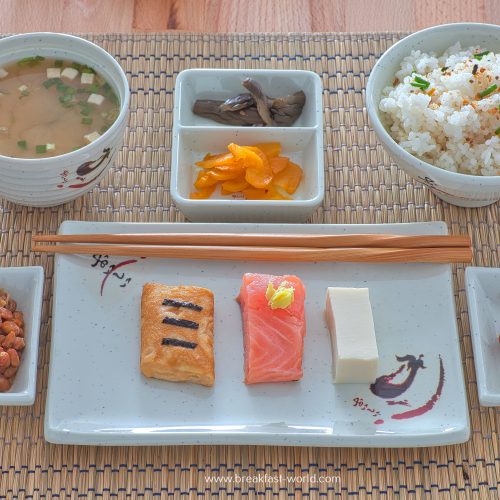
Asa Gohan
Zutaten
For the rice:
- 100 g (Japanese) short grain rice*
- 2 raw or very soft-boiled eggs
- 2 tbsp. soja sauce
- 2 tsp. Furikake spice mix*
For the miso soup:
- 1 tbsp. Miso paste*
- 1 tbsp. Dashi broth (powder)*
- 250 ml hot water
- 60 g (Silk) tofu cut into 1cm cubes
- 1 tbsp. wakame seaweed soaked in water*
- 1 tbsp. soja sauce
- 1 tbsp. finely chopped green onions
For the salmon:
- 150 g Salmon fillet
- 1 tbsp. lemon juice
- 1 tbsp. freshly grated ginger
- 1 pinch salt
- 1 tbsp. oil for frying
For the omelette:
- 2 eggs
- 2 tbsp. soja sauce
- 2 tsp. Rice wine (mirin)*
- 1/2 tsp. sugar
- 1 pinch salt
- 1 tbsp. oil for frying
- 1/4 Nori seaweed sheet* cut into fine strips (approx. 1 cm long and 0.3 cm wide)
For the Natto:
- 1 package Natto*
- 2 tbsp. Tsuyu (Japanese fish-soy sauce)*
- 1 tsp. mustard
In addition:
- 1 each tbsp. Tsukemono* (pickled Japanese vegetables) of your choice e.g. daikon radish, cucumber, umeboshi (plum)
Anleitungen
Rice
- Cook rice according to the instructions on the packet. Let it evaporate a little and put it into two bowls.
- Place a raw or soft-boiled egg on both rice bowls. Mix the rice and egg together well. Season the rice with soy sauce and a little furikake seasoning.
Miso soup
- Cut the soaked seaweed into small pieces. Stir dashi stock (powder) into the hot water. Add miso paste and stir everything well so that there are no more lumps. Add the tofu and seaweed.
- Season the soup with soy sauce and garnish it with spring onions at the end. Put the miso soup into two bowls and serve quickly.
Salmon
- Rinse the salmon fillet under cold water and pat dry. Drizzle with a little lemon juice and marinate for a few minutes.
- Cut the salmon into finger-width strips and fry briefly on all sides in hot oil. Alternatively, you can grill the salmon. Place the salmon pieces on two plates, season with salt and decorate with a little freshly grated ginger. Serve immediately (if necessary, keep warm in the oven until all other components are ready).
- Tip: Instead of salmon, you can also use tofu (pure or fried). That tastes very good as well.
Omelette
- Whisk eggs, season with soy sauce, rice wine (mirin), sugar and salt. Heat oil in a pan. Bake two thin omelettes from the egg mixture. Carefully roll up the omelettes and cut them into slices.
- Decorate the omelettes with some nori seaweed leaves. Place the pieces on two plates and serve immediately. If necessary, briefly keep warm in the oven until all other components are ready.
Natto
- Defrost and heat Natto in the microwave according to the instructions. Season with tsuyu sauce and mustard.
- Tip: It is best to mix natto with rice before consumption. Doing so, the taste is not that extreme.
Tsukemono (Pickled Vegetables)
- Put 1 - 2 tablespoons of each of the different Tsukemono varieties on separate plates/bowls and serve as a side dish.
Notizen
If you like this post, I look forward to a rating (star bar) or a nice comment!
Thanks a lot!
Perhaps you would also like to subscribe to my page. If so you will be regularly informed about new posts.

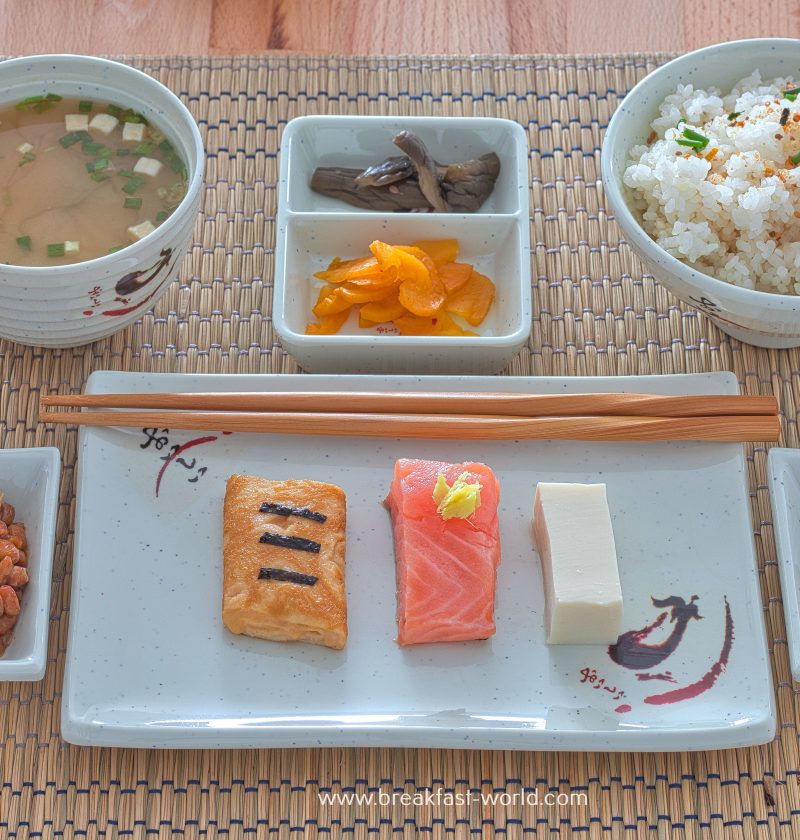

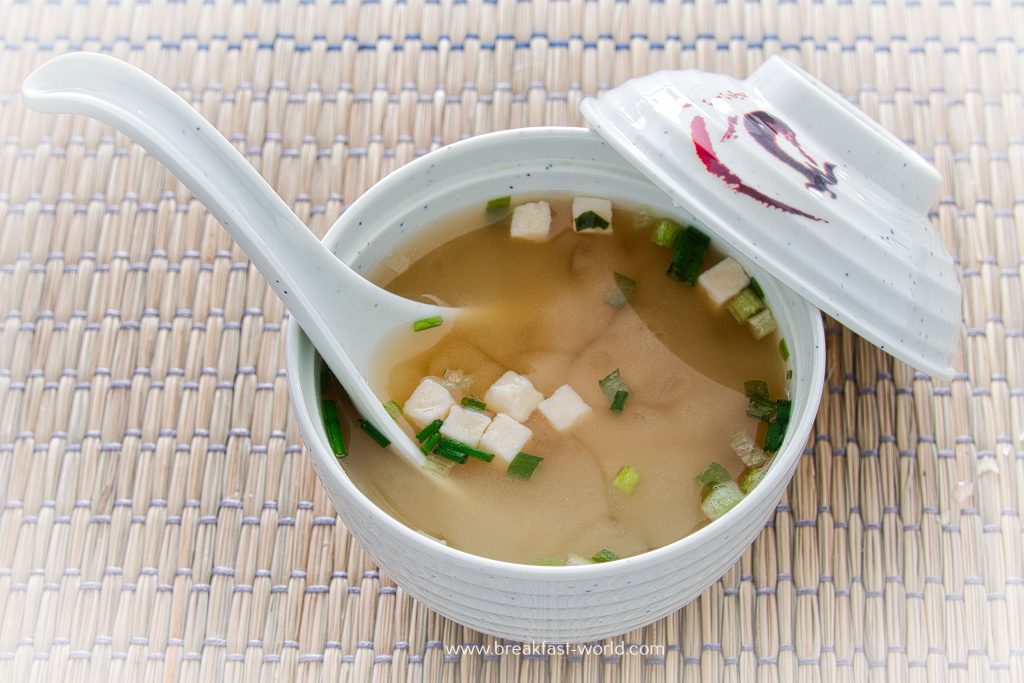
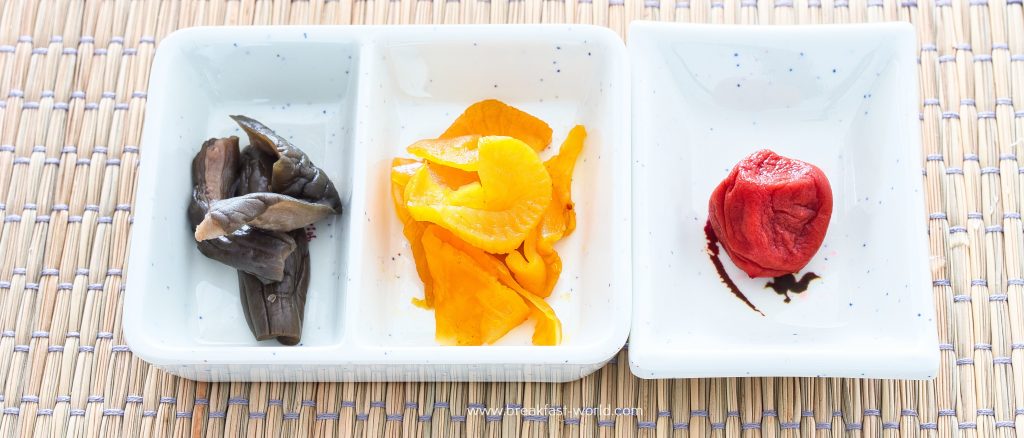

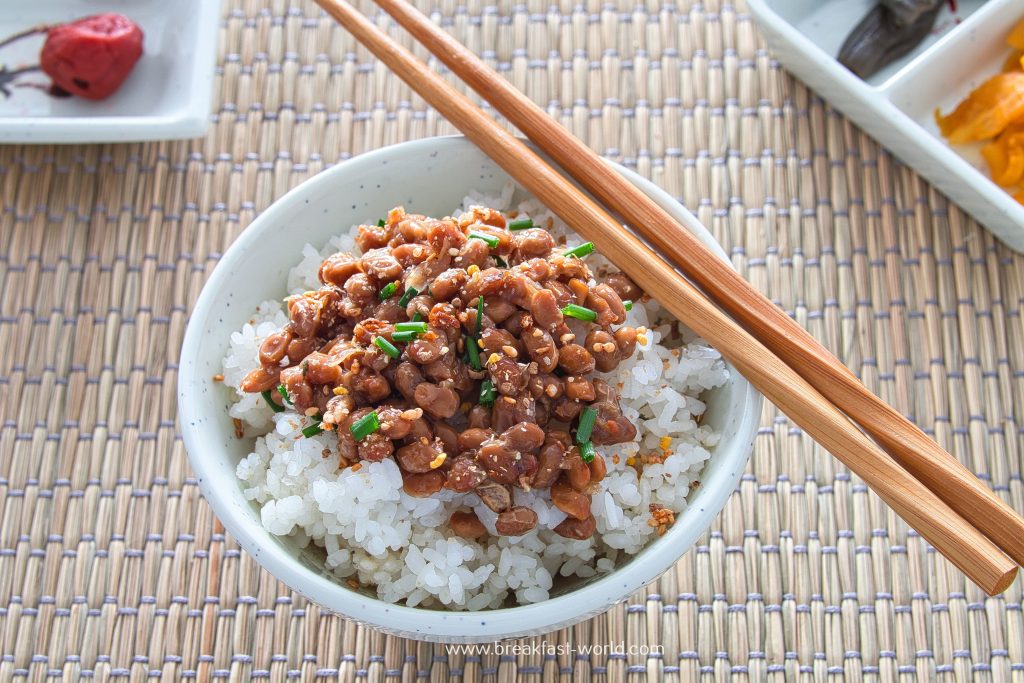



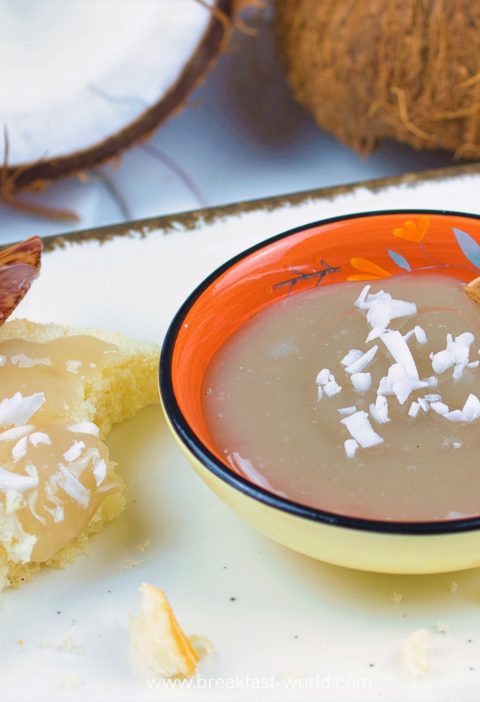


Thank you for sharing superb informations. Your web-site is very cool. I am impressed by the details that you have on this website. It reveals how nicely you understand this subject. Bookmarked this web page, will come back for extra articles. You, my pal, ROCK! I found just the information I already searched all over the place and simply couldn’t come across. What an ideal website.
I was just looking for this info for some time. After 6 hours of continuous Googleing, at last I got it in your website. I wonder what is the lack of Google strategy that do not rank this type of informative web sites in top of the list. Generally the top websites are full of garbage.
Excellent read, I just passed this onto a friend who was doing a little research on that. And he actually bought me lunch since I found it for him smile Therefore let me rephrase that: Thanks for lunch!